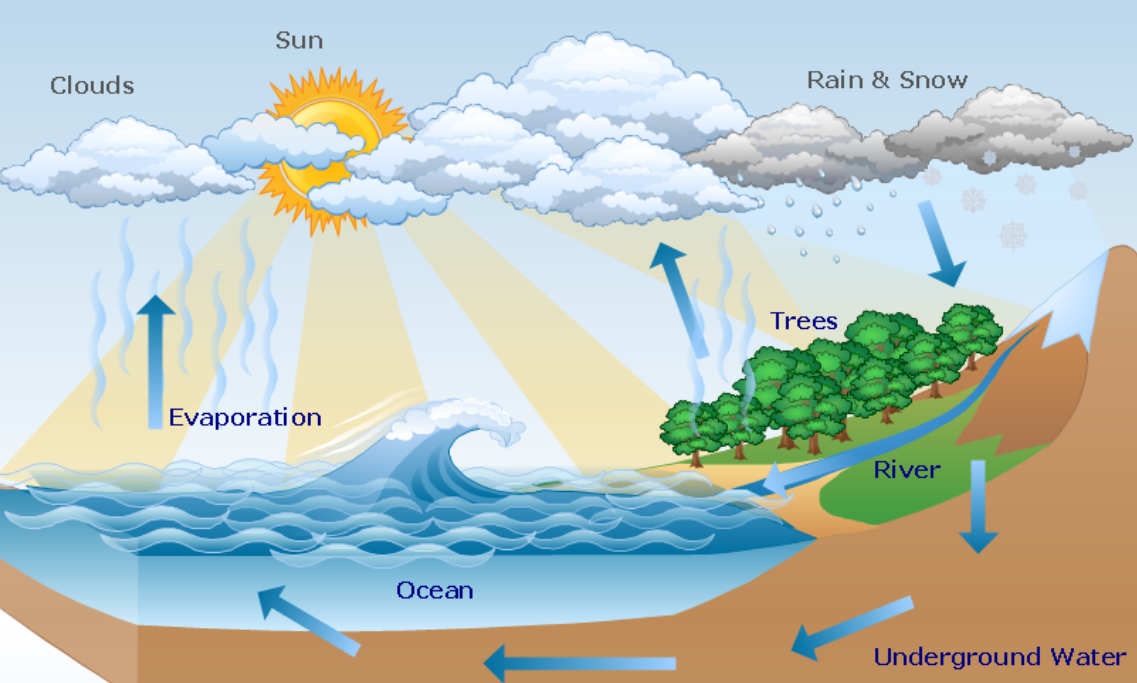
Draw a neat and labeled diagram of water cycle in nature.
Answer
574.2k+ views
Hint: The water cycle is also called as hydrologic cycle, where there is a continuous circulation of water in the earth atmosphere that takes place, where the water cycle is the motion of water from the ground to the atmosphere and back again to the ground.
Complete answer:
The important steps involved in the water cycle are

Evaporation: This is the process of converting the liquid form into a gaseous form, for the conversion to happen, some energy is required, it may be sunlight, or any other energies in the atmosphere, this one of the important steps of the water cycle.
Even one can experience the evaporation in their own body, during exercise, or during dehydration, etc.
Transpiration: It is another important step of water cycle happen in the environment, where planets contain the structure called stomata, present on the surface of the leaves, where enters is expelled in the form of vapour to the atmosphere, it is mainly dependent on atmosphere humidity, out of total water consumed by the only 1% is utilized for growth and remaining is send back to atmosphere.
Condensation: It is opposite to that evaporation, in this step, gaseous form of water, that is water vapour is condensed to water, and in this generally heat is released.
Precipitation: If the condensation water grows and becomes too large, and when they have collision and coalescence, this results in the precipitation, generally precipitation is in the form of rain, hail, eff.
Run off: If the excessive precipitation occurs, it results in run off, because earth also becomes saturated, and the rivers and lakes are mainly responsible for run off, out of this some percent is evaporated, while most of the water goes back to the oceans.
Hence, the correct answer is option (B).
Note: Water cycle involves the exchange of energy, where it is responsible for the temperature changes, when the water evaporates it takes up the energy and cools the environment, and it releases , mainly during condensation, it releases the energy and heats up the climate.
Complete answer:
The important steps involved in the water cycle are

Evaporation: This is the process of converting the liquid form into a gaseous form, for the conversion to happen, some energy is required, it may be sunlight, or any other energies in the atmosphere, this one of the important steps of the water cycle.
Even one can experience the evaporation in their own body, during exercise, or during dehydration, etc.
Transpiration: It is another important step of water cycle happen in the environment, where planets contain the structure called stomata, present on the surface of the leaves, where enters is expelled in the form of vapour to the atmosphere, it is mainly dependent on atmosphere humidity, out of total water consumed by the only 1% is utilized for growth and remaining is send back to atmosphere.
Condensation: It is opposite to that evaporation, in this step, gaseous form of water, that is water vapour is condensed to water, and in this generally heat is released.
Precipitation: If the condensation water grows and becomes too large, and when they have collision and coalescence, this results in the precipitation, generally precipitation is in the form of rain, hail, eff.
Run off: If the excessive precipitation occurs, it results in run off, because earth also becomes saturated, and the rivers and lakes are mainly responsible for run off, out of this some percent is evaporated, while most of the water goes back to the oceans.
Hence, the correct answer is option (B).
Note: Water cycle involves the exchange of energy, where it is responsible for the temperature changes, when the water evaporates it takes up the energy and cools the environment, and it releases , mainly during condensation, it releases the energy and heats up the climate.
Recently Updated Pages
Why are manures considered better than fertilizers class 11 biology CBSE

Find the coordinates of the midpoint of the line segment class 11 maths CBSE

Distinguish between static friction limiting friction class 11 physics CBSE

The Chairman of the constituent Assembly was A Jawaharlal class 11 social science CBSE

The first National Commission on Labour NCL submitted class 11 social science CBSE

Number of all subshell of n + l 7 is A 4 B 5 C 6 D class 11 chemistry CBSE

Trending doubts
Differentiate between an exothermic and an endothermic class 11 chemistry CBSE

10 examples of friction in our daily life

One Metric ton is equal to kg A 10000 B 1000 C 100 class 11 physics CBSE

Difference Between Prokaryotic Cells and Eukaryotic Cells

1 Quintal is equal to a 110 kg b 10 kg c 100kg d 1000 class 11 physics CBSE

State the laws of reflection of light




